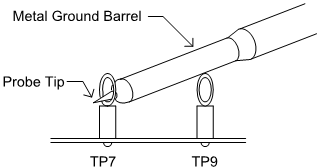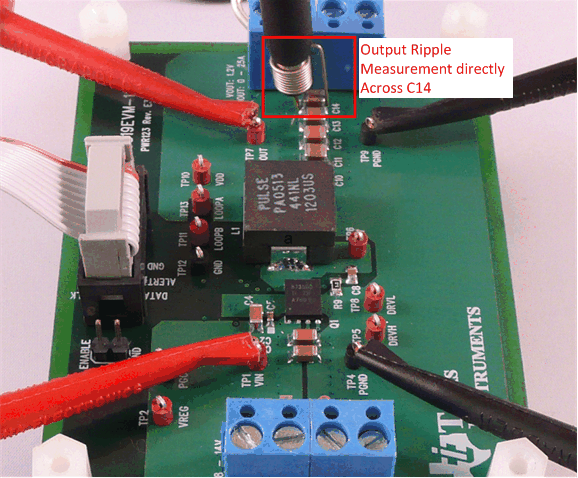SLVU719B May 2012 – November 2021 TPS53819A
4.2 Test Equipment
Voltage Source: The input voltage source VIN should be a 0-V to 14-V variable DC source capable of supplying 30 ADC. Connect VIN to J4 as shown in Figure 4-2.
Multimeters:
- V1: VIN at TP1 (VIN) to TP4 (PGND)
- V2: VOUT at TP7 (VOUT) to TP9 (PGND)
- A1: VIN input current
Output Load: The output load should be an electronic constant-resistance mode load capable of 0 ADC to 25 ADC at 1.2 V. An electronic constant-current load is also acceptable.
Oscilloscope: A digital or analog oscilloscope can be used to measure the output ripple. The oscilloscope must be set for 1-MΩ impedance, 20-MHz bandwidth, AC coupling, 2-μs per division horizontal resolution, 20-mV per division vertical resolution. As shown in Figure 4-1, test points TP7 and TP9 can be used to measure the output ripple voltage by placing the oscilloscope probe tip through TP7 and holding the ground barrel to TP9. It is not recommended to use a long leaded ground connection because this may induce additional noise due to a large ground loop. Alternatively, the output ripple can be measured directly across C14 with a short ground lead as shown in Figure 4-2. To measure other waveforms, adjust the oscilloscope as needed.
 Figure 4-1 Tip and Barrel Measurement for VOUT Ripple
Figure 4-1 Tip and Barrel Measurement for VOUT Ripple Figure 4-2 Probe with Short Ground Lead for VOUT Ripple Across C14
Figure 4-2 Probe with Short Ground Lead for VOUT Ripple Across C14Fan: Some of the components of this EVM can approach temperatures of 60°C during operation. A small fan capable of 200–400 LFM is recommended to reduce component temperatures while the EVM is operating. Exercise caution when touching the EVM while the fan is not running and always exercise caution when touching any circuits that can be live or energized.
Recommended Wire Gauge:
- VIN to J1 (12-V input): The recommended wire size is 1 × AWG #14 per input connection, with the total length of wire less than four feet (two feet input, two feet return).
- J3 to LOAD: The minimum recommended wire size is 2 × AWG #14, with the total length of wire less than four feet (two feet input, two feet return).